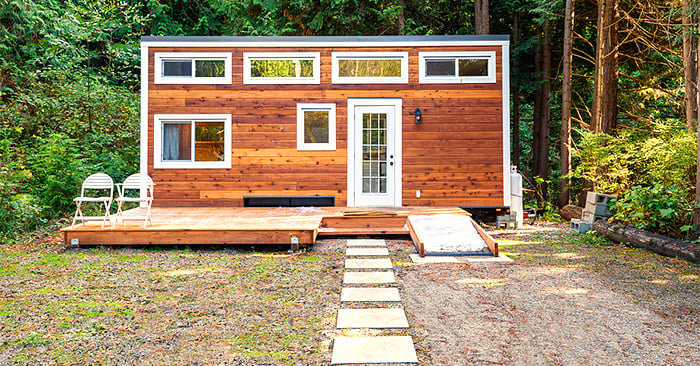Does a smaller home sound like the perfect fit for you? Not everyone needs—or wants—a sprawling house with multiple bedrooms and living spaces. In fact, for many people, a more compact home is the ideal solution.
Maybe you’re single and don’t need much space. Perhaps you’re looking to downsize, cut costs, or simply avoid the maintenance headaches of a larger home. Whatever the reason, smaller homes are growing in popularity, and recent trends suggest that more buyers are willing to trade square footage for affordability.
According to this Realtor Magazine article, a recent survey revealed that homebuyers today are looking for slightly less space than they were 20 years ago. While most buyers still prefer a traditional home, 35% of buyers are open to smaller living spaces—especially if it means a better price or a more functional layout.
Why Aren’t Builders Constructing Smaller Homes?
If demand for smaller homes is increasing, why aren’t builders rushing to meet it? The reality is that builders generally aim to maximize profits by constructing larger homes on available lots. More square footage usually translates to higher sale prices, making it financially impractical to build tiny homes on prime real estate. Additionally, zoning laws in many areas don’t allow for smaller homes or restrict their placement on certain lots.
However, a potential solution is gaining traction: Accessory Dwelling Units, or ADUs.
What Are ADUs, and Why Are They Gaining Popularity?
ADUs—sometimes called guest houses, granny flats, or in-law suites—are small, secondary housing units built on the same property as a primary home. They can be detached, attached, or even converted from existing spaces like garages or basements. Because ADUs are compact and efficient, they can be an affordable way to add living space without the cost of purchasing a separate property.
Some states and cities are loosening regulations to make it easier to build ADUs. For example, Massachusetts recently passed a law simplifying the approval process, allowing more homeowners to construct these units. Typically, ADUs are capped at a percentage of the main home’s size or a set square footage (often around 900 square feet). This makes them ideal for:
- Aging parents who want to live near family while maintaining independence
- Young adults who need a budget-friendly housing option
- Homeowners looking to generate rental income
- People seeking a downsized, minimalist lifestyle
How Much Do ADUs Cost?
Building an ADU is typically more affordable than buying a standalone home. However, costs vary widely based on location, size, and construction type, ranging from around $80,000 to $400,000 for a fully built unit, according to Realtor.com. The lower end of that range is a bargain compared to home prices in many markets, although it starts to rival the cost of a full-sized house on the higher end of that spectrum.
Interestingly, if you’re looking for an ultra-affordable option, you can even buy an ADU on Amazon! Some prefab ADU kits start as low as $8,500 and can go up to around $55,000. These tiny homes can be shipped directly to your door—often with free delivery. However, there are some important factors to consider before clicking “Add to Cart.”
Some Things to Consider Before Buying an ADU
If an ADU sounds like the perfect solution for you or a family member, there are a few key things to keep in mind before diving in:
- Local Regulations: Just because ADUs are becoming more accepted doesn’t mean they’re allowed everywhere. Before purchasing or building one, check your local zoning laws and permitting requirements. Ideally, get full written approval from local officials before even buying one.
- Insurance Considerations: Not all homeowners insurance policies cover ADUs, and adding one to your property could impact your existing coverage. Speak with your insurance provider to understand your options.
- Construction and Assembly: Some prefab ADUs arrive ready to use, while others come as kits that require professional assembly. Make sure you know what you’re getting into before making a purchase. You may have to factor in hiring contractors to do some prep work to the site, assemble it entirely, or do some finishing touches.
- Utility Connections: Even if the structure itself is affordable and comes fully assembled, don’t forget about the costs of hooking up water, electricity, and sewage. These expenses can add up quickly, especially if your property isn’t already set up for an additional dwelling. You may have to run new pipes and electricity lines to the new unit, which are often best left to licensed professionals to install.
- Property Aesthetics and Resale Value: Your ADU doesn’t have to be an exact replica of your main house, but it should complement the property’s overall design. A well-integrated ADU can add value, while one that looks out of place might have the opposite effect.
The Takeaway:
As housing costs continue to rise, ADUs are emerging as a viable alternative for those who need a smaller, more affordable living space. Whether you’re looking for a place for a family member, a rental unit, or simply a downsized home, an ADU might be the perfect fit. With zoning laws evolving and prefab options becoming more cost-effective and accessible, this trend is likely to grow in the coming years. Just be sure to do your research, follow local regulations, and plan carefully to ensure your ADU is a smart investment rather than a costly mistake.




